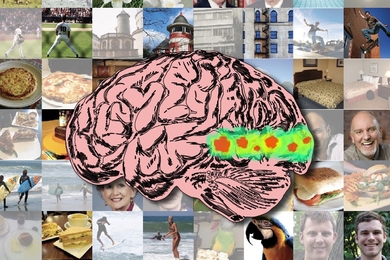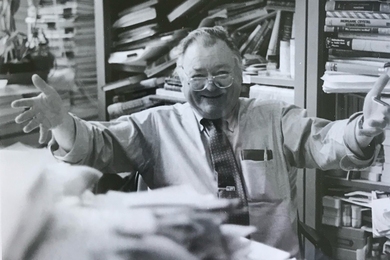A new Compton Gallery exhibition opening on Sept. 9, presented by the Center for Advanced Visual Studies and the MIT Museum, explores possible relationships between finance and buildings through an installation of models, videos, photographs and drawings.
"Red Lines, Death Vows, Foreclosures, Risk Structures: Architectures of Finance from the Great Depression to the Sub-Prime Meltdown," an exhibition by designer Damon Rich and the Center for Urban Pedagogy (CUP), immerses visitors in a landscape of pulsating capital and city buildings. The immense head of a pioneering real estate appraiser gazes over a field of floor-mounted house portraits. A jagged free-standing graph of the 20th century's prime rate reflects a flickering neon sign advertising the process of block busting. A paired set of projected videos features interviews with mortgage stakeholders including financiers, anti-foreclosure counselors, and government regulators - and their voices haunt the gallery.
"Red Lines" aims to support a broader, richer conversation about how society finances its living environments and how the financial decisions of individuals have impacted families, communities and businesses. Through public programs, contributions to the curriculum at MIT, and off-site works like the educational video Predatory Tales produced with Lawrence Community Works of Lawrence, Massachusetts, "Red Lines" provides multiple sites where new dialogues about these crucial topics can begin.
During his year-long residence at MIT's Center for Advanced Visual Studies (CAVS), guest curator Damon Rich, designer and founder of CUP, studied the fundamentals of real estate markets: property law, pro-formas, appraisal, mortgages, and more. Working with MIT students and volunteers, he traveled to Washington to visit and interview representatives of the Mortgage Bankers Association and the Comptroller of the Currency. In Chicago, Rich and Meg Rotzel of CAVS created a video with the National Training and Information Center about the anti-redlining movement of the 1970s, and the democratic reforms it brought to banking. In Boston, Rich spent time with mortgage brokers as they relaxed after work in bars and restaurants. These interviews, photographs, napkin sketches, and yellowed clippings provide the material for the work in the exhibition.
This exhibition is supported by the National Endowment for the Arts, the Graham Foundation, the LEF Foundation, the New York State Council for the Arts, and the Loeb Fellowship of the Harvard Graduate School of Design.
"Red Lines" runs from Sept. 10 to Dec. 21. Admission is free and open to the public. For more information, contact Meg Rotzel, MIT Center for Advanced Visual Studies, 617-253-4415, e-mail: mrotzel@mit.edu.
A version of this article appeared in MIT Tech Talk on September 10, 2008 (download PDF).







